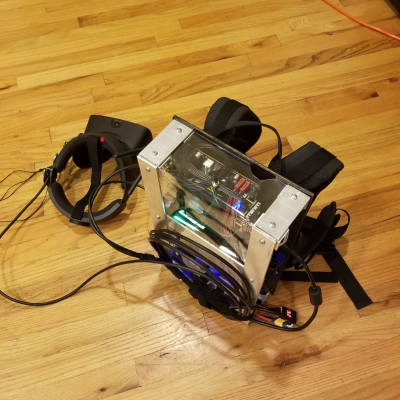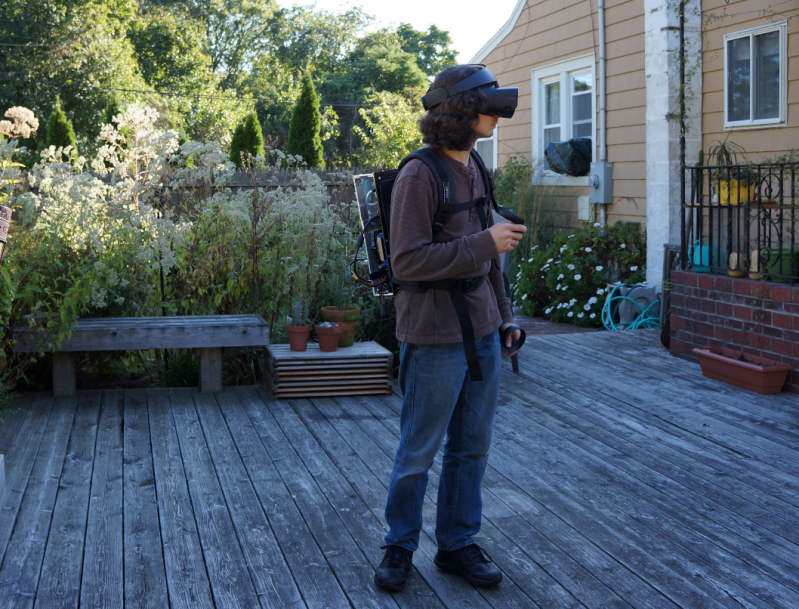Persistence is what a hacker needs to make it to their goal. That’s exactly what it took for [Erik] to make an untethered VR backpack system.
Starting way back in the Spring of 2019, [Erik] began working on an untethered VR system. Sure, the Oculus Quest was coming out, but it wouldn’t be compatible with the game library of PC based systems. [Erik] decided he wanted the best of both worlds, so he decided to build a backpack that carries a computer powerful enough to drive the Rift S.
The initial system was to use a cut-up backpack, an HP mini PC with an external Nvidia 1060 GPU, and a basic DC-DC converter. The result? Just about nothing worked. The HP’s boot process didn’t play well with an external GPU.
[Erik] went through several iterations of this project. He switched over to a standard PC motherboard and tried a few different DC-DC converters. He settled on a device from HDPLEX rated at 200 watts continuous. The converter plugs directly into a standard 24-pin ATX motherboard power connector and isn’t much larger than the connector itself.
 The old backpack with its added padding and wood frame gave way to a Zotac VR go backpack. Only the straps and frame of the Zotac are used, with [Erik’s] custom parts mounted using plywood and 3D printed parts. The outer frame is aluminum, with acrylic panels.
The old backpack with its added padding and wood frame gave way to a Zotac VR go backpack. Only the straps and frame of the Zotac are used, with [Erik’s] custom parts mounted using plywood and 3D printed parts. The outer frame is aluminum, with acrylic panels.
Power comes from 7000 mAH LiFe batteries, with each pack providing an hour of runtime. The Backpack can hold two packs though, so wiring them up in parallel should double that runtime.
We have to say this is an extremely well-documented build. [Erik] explains how he chose each component and the advantages (and pitfalls) of the choices he made. An example would be the RAM he picked. He chose DDR4 with a higher spec than he needed, just so he could undervolt the parts for longer run-times.
Not everything in VR is fun and games though – you can ditch that monitor and go with a VR desktop.

















Cool build. For the work I do a Desktop is usually more applicable. My PC is very old now though (12jr) and I’m thinking of buying parts for a new one, and so I accidentally bumped into a cots product very similar to this.
https://duckduckgo.com/html?q=HP+backpack+vr+system
Had the chance to test one for a VR escape game. Battery lasted a max of 45 min so the game should be completed in 30-ish min. Was 8 – 10 months ago so maybe they improved battery time. But sure, the experience worth it …
A laptop with decent 5Ghz wifi and a Quest with Virtual Desktop would allow for portable, tetherless play without needing to lug a big heavy computer on your back. You could also plug the laptop in to a power source and attach a 10000mah battery to the back of the head strap for 8+ hours of play time.
From what I’ve heard, everyone that I know that owns a Quest and has tried fully wireless play with their computers has reported that there’s unbearable latency between doing something with your controllers or your headset (around 15ms or so of latency). I personally have a Rift S for my desktop VR play and don’t have a Quest to try it out but that’s just what I’ve heard from some people
Or you can have the laptop and battery as scheeseman said, but you carry it in a normal backpack and use the Oculus link to connect the quest. This way you get rid of the latency issue.
Please, I details of this your approach.
Do you know that Zotac and HP already offers way better backpack PCs? I saw the Zotac one at Marvels Avengers VR and Dreamscape VR and runs like a champ.
But they can run awfully more expensive than the DIY route.